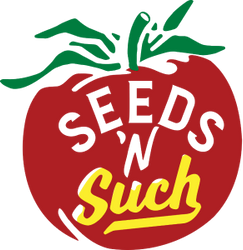
7 Unique Vegetables You Didn’t Know You Could Grow At Home
If you’re starting to get a little bored with your garden, you’re not alone.
Who doesn’t love cherry tomatoes or French green beans? We’d be lying if we said we didn’t. But it’s never a bad idea to branch out and try something new every now and then.
Switch up your weekly dinner routine with any one of these unusual vegetables! Find a brand new recipe or add a unique twist to your favorite comfort food. All produce, especially specialty produce, is only becoming more expensive–so save some money by growing your own.
What follows is a list of some rare and unique seeds available at Seeds ‘N Such. These vegetables are among our most flavorful and eye-catching varieties! Some vegetables, like Bird House Gourd and Luffa Sponge Gourd, are perfect for crafts. Strawberry Corn and Cow Horn Okra are glorious ornamentals that double as edibles.
Take a few minutes to browse this list and pick out a few new varieties to try this season. All of the seeds on this list can be directly sown, so there’s still time for you and your family to experiment with new vegetables this growing season!
-
Bird House Gourd
Bird House Gourd is not typically known for its fine flavor, but many gardeners grow the squash to craft with its bottle-shaped fruits–it’s where this plant gets its other name, “bottle gourd.”
Bird House Gourd is an annual vining plant in the same family as winter squash and thrives in the same growing conditions: warm, fertile soil and full sun. The oblong, almost hourglass-shaped fruits have a thick skin that hardens when cured. The cured skin is waterproof, which is why this fruit makes the perfect biodegradable cups, bowls, and utensils!
Of course, the fruits can also be crafted into the world’s cutest birdhouse. Take a cured gourd and very carefully cut a small, circular hole with a sharp knife. Empty the gourd by removing the dried inner flesh, and hang the gourd somewhere close by so you can watch the thankful birds!
-
Luffa Sponge Gourd
Luffa Sponge Gourds are another fun crop to grow for any crafty gardener or DIYer. Luffa Sponge is an exotic member of the cucumber family, native to Southeast Asia. The vines are vigorous growers that produce eight to ten-inch-long cucumber-like fruits. The blossoms and young fruits are edible and can be prepared like zucchini, but must growers cultivate Luffa Sponge for–you guessed it–loofas.
To make your own sponge, you’ll need to let the fruits cure on the vine, which takes well over 100 days. When the fruits have dried to a brown color, they can be picked, and the skin peeled back to reveal a fibrous core, perfect for everything from washing dishes, scrubbing sinks, and of course, exfoliating skin. Just don’t use the same luffa for all three tasks.
-
Early White Vienna Kohlrabi
While it looks like something out of a sci-fi movie, kohlrabi is really just a vegetable grown for its thick, succulent stem. A member of the brassica family, kohlrabi is a cool-season crop that thrives in spring and fall, providing calories and nutrition during the leaner months.
Early White Vienna Kohlrabi plants form a bulb at their base that is ready to harvest in about 55 days. The bulb is delicious raw in salads, roasted in the oven, or cooked in soups. Kohlrabi, a german word, translates to “cabbage turnip,” which is a fair description of the vegetable.
-
Strawberry Corn
Growing your own corn is as easy as eating it. Well, almost. Corn prefers to be directly seeded in blocks to ensure proper cross-pollination and a hefty harvest! The seeds are quick to germinate and need very little maintenance–just the occasional weeding and watering until the plants are established.
Strawberry corn is a truly unique variety, and it’s a favorite with kids. Not only is the corn a beautiful mahogany color, but the cobs are shaped like strawberries, too! The two- to three-inch cobs are perfect for DIY fall decor, or you can save the kernels for popping.
-
Dragon Tongue Bean
Quite possibly the most beautiful bean currently in existence, Dragon Tongue, is a unique bush bean whose mature yellow seedpods are marked with purple stripes. This high-yielding, versatile bean can be enjoyed as a fresh snap bean or a shelled dry bean. Dragon tongue is a space saver in the garden, only growing about two and a half feet tall, and matures in about 60 days.
-
Cow Horn Okra
Okra tends to be a polarizing vegetable–you either love it or hate it. We love Cow Horn for its sweet taste and the aesthetic it brings to the garden. Plants typically reach ten feet tall and produce lovely yellow flowers that will put you in mind of hibiscus. The spineless, tender seedpods have a slight curve to them that gives this variety its descriptive name.
Harvest Cow Horn when the seedpods reach about six inches long and prepare them any way you’d prepare okra–fried, cooked with peppers and onion in gumbo, or pickled!
-
Armenian Cucumber
One look at this unique vegetable, and you’ll understand how it got its other moniker: “snake melon.” Armenian cucumbers are technically a melon but are more akin to cucumbers in taste. The striped skin encases sweet, crisp flesh.
Trellis the vining plants for straight fruits, or grow the vines on the ground to encourage curling. Begin harvesting Armenian cucumbers in 70 days, and enjoy the sweet and burpless fruits fresh in salads, atop sandwiches, or as pickles!
Conclusion
Exotic varieties aren’t just for the adventurous gardener–these rare and unusual vegetables aren’t any more difficult to grow than their common cousins. Impress your friends and family with these unique vegetables, and just see if you don’t start a new garden trend!
